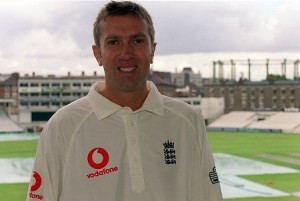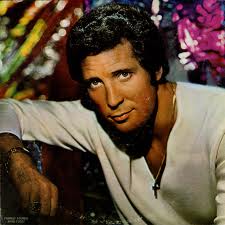
A gradual but inevitable descent into cricket-based loathing and bile.
One Of The Great What Ifs, #1: Simon Jones Was A Peak Of Humankind
Predicting things really isn’t our forte. In more than two years of series and match predictions, we’ve only got about two things right, a success rate roughly in line with Aleem Dar these days. So when Editor Steve asked us to come up with an idea for a new series of articles, going down the ‘what might have happened’ route was the last thing we wanted to do. Sadly, we couldn’t think of anything else – the sound of a sock full of snooker balls being tapped on the table isn’t exactly conducive to creativity – so here we are.
While Matthew Hoggard announcing his retirement brought a melancholy vibe to the 51allout office, it was the following day’s announcement that Simon Jones is giving up First Class and List A cricket that really brought out the tears. During the 2005 Ashes he was a cricketing god. By the end he was never to play international cricket again. What better candidate could there be to kick off our new feature?

Our ‘What if Ian Salisbury had actually been able to pitch the ball on the cut strip?’ article has had to be delayed slightly.
Rugged. Handsome. Brick Shithouse. Just some of the words used to describe Simon Jones, who really ought to be winner of Wales’ Sexiest Man in perpetuity. Unfortunately for Jones The Ball, whilst his body may make women (and internet geeks) squeal, his bones are made of plywood, his joints are as robust as damp lettuce leaves and his muscles are as overworked as Samit Patel’s jaw. But what if he was a specimen that doctors behold as perfection? What if he hadn’t been so injury-prone?
The first thing to say in our little scenario is we’re not taking into account his terrible injury at Brisbane in 2002 – the cut-off point is the moment in 2005 when he hurt his ankle at Trent Bridge – everything up until then did indeed happen.
So to the Oval, and England are unchanged. Fortunately Jones’s ankle injury, which allowed him to bowl just four overs in the second innings at Nottingham, was nothing serious (“His healing powers are remarkable,” said Duncan Fletcher) and he arrived in Kennington 100% fit. England made 366ao in their first innings, but in reply Australia were in trouble quickly as Jones removed the openers in his first spell. They continued to struggle as the rest of the batsmen soon followed Hayden and Langer back to the pavilion. They were faring little better in their second innings, until Flintoff dropped Michael Clarke at slip (“You’ve just dropped the Ashes”, joked Clarke). Young pup went on to make 158 of the finest runs you’ll see, taking Australia to a final score of 335ao. Their lead of 125 should not have been enough, but for once England rued not having an extra batsman. Faced with a deadly final day pitch, Shane Warne once again ran through the team and wickets fell at an alarming rate. Jones was the last man out (for a duck) and England fell 10 runs short. Australia retained the Ashes.
Having made just 180 runs all series, Matthew Hayden was dropped, never to return to the Test XI. He now hosts a television cooking show, the unique selling point of which is that he and his guest chef have to find, prepare and cook roadkill.
Meanwhile England were shocked into further improvement. Despite their fabulous 2004/05 run of form, they had lost the Ashes just when they finally looked to be in their grasp. Whilst the Australians partied, Duncan Fletcher took England to a post-series training camp, where their mental and physical attributes were tested and honed.
The four-man pace attack remained central to England’s progression. With a reduced workload, Flintoff remained fit for long periods of time. Although a sixth proper batsman might have helped on that fatal final day at the Oval, England kept their preferred balance. Despite a veritable shitload of runs for Durham and in limited overs internationals, Paul Collingwood never quite made it as an England Test regular.
Following famous victories against Pakistan and India, England headed Down Under in 2006 with a settled team. Australia meanwhile were confident – and cocky. At Brisbane, four years on from his awful injury, Simon Jones was at his absolute peak. Taking the new ball, his first over to Justin Langer contained six balls of venom and swing, the final ball trapping him LBW. Langer’s latest opening partner, fresh on the back of 279 against Victoria, was Chris Rogers (following Hayden’s axing Australia constantly searched for a reliable opener, to no avail). The pace attack was too much for Australia, who lost both the first Test, and famously, the second at Adelaide.
It was Jones’ use of reverse swing that really stood out in that series, and by the time England avoided defeat at Sydney to return the urn for the first time in 20 years, he was a household name.
The fabled four-man attack couldn’t stay united forever though, and gradually Hoggard, Harmison and Flintoff began to miss games. Jimmy Anderson was recalled after an absence of four years, but his swing bowling looked as innocuous as ever and he was still a shy and quiet character in a dressing room dominated by Jones et al. After two games against the West Indies in 2009 he returned to Lancashire, where he remains a decent county bowler but nothing more.
Simon Jones meanwhile announced his retirement from international cricket ahead of the Sydney Test in January 2014, his fourth and final Ashes tour. His England team-mates (Cook, Carberry, Bell, Pietersen*, Bopara, Stokes, Read+, Bresnan, Onions and Panesar) gave him a guard of honour and the SCG scoreboard displayed his Test record:
Tests: 101, Wickets: 406, Average: 24.27



2 Comments
Post a Comment
1
Nobby
17 Sep 2013 04:08
I was genuinely emotionally involved in that. A great idea.
A few suggestions (some of which are touched upon in the last para, but need fleshing out) – what if:
-Bopara had stayed at 3 through 09 Ashes and beyond (therefore Trott never made an appearance)
-Collingwood had scored 500 runs in 10/11 and was made captain after Strauss retired
-alternatively, Bell/Morgan/Broad (the three non-Cook players they interviewed) were appointed captain
-England beat Sri Lanka in the 2011 World Cup semi final
-Chris Tremlett had taken the hat trick against Bangladesh in 06
-Barry Richards (and/or any other apartheid era Test capped Saffers) had turned out for England
-similarly Phil Jaques/James Pattinson/Ryan Harris/Chris Rogers playing for England
2
Alex G
16 Sep 2013 21:28
Can I nominate my favourite cricketing what if…..what if Atherton hadn’t ridicuously declared with Hick 98 not out. It generally involves a remarkable fightback in the 94/95 Ashes, before Hick establishes himself as a colossus of the international game with his new found confidence and security at the top level.